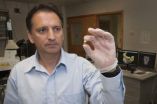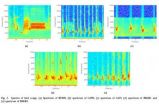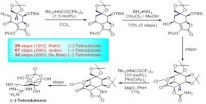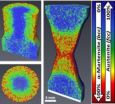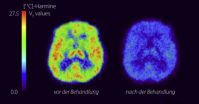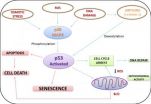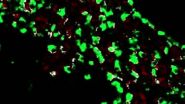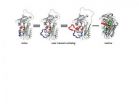Free pores for molecule transport
2014-07-31
This news release is available in German.
Metal-organic frameworks (MOFs) can take up gases similar to a sponge that soaks up liquids. Hence, these highly porous materials are suited for storing hydrogen or greenhouse gases. However, loading of many MOFs is inhibited by barriers. Scien-tists of Karlsruhe Institute of Technology (KIT) now report in Nature Communications that the barriers are caused by cor-rosion of the MOF surface. This can be prevented by water-free synthesis and storing strategies.
MOFs are crystalline materials consisting of metallic nodes ...
Scientists shine bright new light on how living things capture energy from the sun
2014-07-31
Since Alexandre Edmond Becquerel first discovered the photovoltaic effect in 1839, humankind has sought to further understand and harness the power of sunlight for its own purposes. In a new research report published in the August 2014 issue of the FASEB Journal, scientists may have uncovered a new method of exploiting the power of sunlight by focusing on a naturally occurring combination of lipids that have been strikingly conserved throughout evolution. This conservation—or persistence over time and across species—suggests that this specific natural combination of lipids ...
Misinformation diffusing online
2014-07-31
The spread of misinformation through online social networks is becoming an increasingly worrying problem. Researchers in India have now modeled how such fictions and diffuse through those networks. They described details of their research and the taxonomy that could help those who run, regulate and use online social networks better understand how to slow or even prevent the spread of misinformation to the wider public.
Krishna Kumar and G. Geethakumari of the Department of Computer Science and Information Systems, at BITS-Pilani, Hyderabad Campus, in Andhra Pradesh, India, ...
Lead in teeth can tell a body's tale, UF study finds
2014-07-31
GAINESVILLE, Fla. – Your teeth can tell stories about you, and not just that you always forget to floss.
A study led by University of Florida geology researcher George D. Kamenov showed that trace amounts of lead in modern and historical human teeth can give clues about where they came from. The paper will be published in the August issue of Science of The Total Environment.
The discovery could help police solve cold cases, Kamenov said. For instance, if an unidentified decomposed body is found, testing the lead in the teeth could immediately help focus the investigation ...
Scientists discover biochemical mechanisms contributing to fibromuscular dysplasia
2014-07-31
An important step has been made to help better identify and treat those with fibromuscular dysplasia (FMD). FMD causes both an abnormal narrowing and enlarging of medium sized arteries in the body, which can restrict blood flow to the kidneys and other organs causing damage. In a new report appearing in August 2014 issue of The FASEB Journal, scientists provide evidence that that FMD may not be limited to the arteries as currently believed. In addition, they show a connection to abnormalities of bones and joints, as well as evidence that inflammation may be driving the ...
New paper describes how DNA avoids damage from UV light
2014-07-31
BOZEMAN, Mont. – In the same week that the U.S. surgeon general issued a 101-page report about the dangers of skin cancer, researchers at Montana State University published a paper breaking new ground on how DNA – the genetic code in every cell – responds when exposed to ultraviolet (UV) light.
The findings advance fundamental understanding of DNA damage by the UV rays found in sunlight. This damage can lead to skin cancer, aging and some degenerative eye diseases.
"Our paper advances foundational knowledge about how DNA responds to UV radiation. In our experiments, ...
Magnetic resonance imaging in patients with transient ischemic attack
2014-07-31
Transient ischemic attack (TIA) is a temporary event, which portends a higher risk of a disabling stroke following the TIA. However, the evaluation and management of TIA vary worldwide and is debated and controversial. Dr. Mohamed Al-Khaled from University of Lübeck in Germany considered With the development of brain imaging, particularly diffusion weighted imaging-magnetic resonance imaging (DWI-MRI), the diagnosis of TIA changed from time-based definition to a tissue-based one. DWI-MRI became a mandatory tool in the TIA workup. The DWI-MRI provides not only the evidence ...
Ligaments disruption: A new perspective in the prognosis of SCI
2014-07-31
Worldwide prevalence of Spinal Cord Injury (SCI) is ranging from 233 to 755 per million inhabitants, whereas reported incidence lies between 10.4 and 83 per million inhabitants per year. Thus, the socioeconomic impact of SCI associated with cervical trauma is high enough to be encountered within one of the most important worries in vast majority of developed countries.
The ability to predict recovery following SCI is of paramount importance to the physician's role in providing the best care and guidance to patients and families during the illness. Diagnosis of cervical ...
Brother of Hibiscus is found alive and well on Maui
2014-07-31
Most people are familiar with Hibiscus flowers- they are an iconic symbol of tropical resorts worldwide where they are commonly planted in the landscape. Some, like Hawaii's State Flower- Hibiscus brackenridgei- are endangered species.
Only a relatively few botanists and Hawaiian conservation workers, however, are aware of an equally beautiful and intriguing related group of plants known as Hibiscadelphus- literally "brother of Hibiscus".
Brother of Hibiscus species are in fact highly endangered. Until recently only one of the seven previously known species remained ...
Singing the same tune: Scientists develop novel ways of separating birdsong sources
2014-07-31
Researchers at the University of California, Los Angeles and the Chinese Academy of Sciences have pioneered a new study that could greatly improve current methods of localising birdsong data. Their findings, which ascertain the validity of using statistical algorithms to detect multiple-source signals in real time and in three-dimensional space, are of especial significance to modern warfare.
Recently published in the journal Unmanned Systems, the study demonstrates the validity of using approximate maximum likelihood (AML) algorithms to determine the direction of arrival ...
Gulf oil spill researcher: Bacteria ate some toxins, but worst remain
2014-07-31
TALLAHASSEE, Fla. — A Florida State University researcher found that bacteria in the Gulf of Mexico consumed many of the toxic components of the oil released during the Deepwater Horizon spill in the months after the spill, but not the most toxic contaminants.
In two new studies conducted in a deep sea plume, Assistant Professor Olivia Mason found a species of bacteria called Colwellia likely consumed gaseous hydrocarbons and perhaps benzene, toluene, ethylbenzene and xylene compounds that were released as part of the oil spill.
But, her research also showed that bacteria ...
Hope for the overweight
2014-07-31
White, brown and beige adipocytes, or fat cells, are inherently different. Each of these cell types has different functions and each plays its own role in metabolism. In the human body, white adipose tissue is by far the most prevalent. Its primary function is energy storage. On the other hand, brown adipocytes utilize available energy to generate heat but are only found in a few places in the adult human body. Beige adipocytes, which represent a special type of brown adipocytes, appear mixed with brown adipocytes in human brown adipose tissue or develop within the white ...
Privileged strategies for direct transformations of inert aliphatic carbon-hydrogen bonds
2014-07-31
Functional group transformations are central to organic synthesis. Traditionally, the functionalities used in such transformations are highly active organic groups such as halogens, ester groups and hydroxyl groups. Carbon–hydrogen bonds are ubiquitous structural motifs in organic compounds, but they are not considered to be functional groups because (1) in general, the bond dissociation energy of a C–H bond is high, and therefore, such bonds are thermodynamically hard to break; and (2) the selective activation of one C–H bond among many similar and different C–H bonds ...
Neutron tomography technique reveals phase fractions of crystalline materials in 3-dimensions
2014-07-31
The method overcomes limitations of existing techniques which are limited to the surface or small-sized specimens, and allows a 3-D representation of the phase fractions within the sample volume. The work has just been published in the journal "Advanced Materials".
"For many engineering applications it is of major importance to characterize the bulk of materials spatially, instead of only probing selected locations. The new method provides exactly that capability, and the HZB-UTK team has demonstrated it by using samples made from stainless steel that undergo a phase ...
Vision-correcting electronic displays could let users dispense with glasses
2014-07-31
Researchers at the MIT Media Laboratory and the University of California at Berkeley have developed a new display technology that automatically corrects for vision defects — no glasses (or contact lenses) required.
The technique could lead to dashboard-mounted GPS displays that farsighted drivers can consult without putting their glasses on, or electronic readers that eliminate the need for reading glasses, among other applications.
"The first spectacles were invented in the 13th century," says Gordon Wetzstein, a research scientist at the Media Lab and one of the display's ...
Vacuum treatment may limit damage after traumatic brain injury
2014-07-31
July 31, 2014 – Controlled application of vacuum pressure is a promising approach to limiting tissue damage after traumatic brain injury (TBI), suggests an experimental study in the August issue of Neurosurgery, official journal of the Congress of Neurological Surgeons. The journal is published by Lippincott Williams & Wilkins, a part of Wolters Kluwer Health.
"Mechanical tissue resuscitation"—consisting of vacuum pressure applied over the injured area of the brain—shows promise as a safe and effective treatment for TBI, according to the research report by Dr. Louis ...
UT Dallas study reveals effect of loud noises on brain
2014-07-31
Prolonged exposure to loud noise alters how the brain processes speech, potentially increasing the difficulty in distinguishing speech sounds, according to neuroscientists at The University of Texas at Dallas.
In a paper published this week in Ear and Hearing, researchers demonstrated for the first time how noise-induced hearing loss affects the brain's recognition of speech sounds.
Noise-induced hearing loss (NIHL) reaches all corners of the population, affecting an estimated 15 percent of Americans between the ages of 20 and 69, according to the National Institute ...
Monoamine oxidase A: Biomarker for postpartum depression
2014-07-31
This news release is available in German.
Many women suffer from baby blues after giving birth. Some even develop full-blown postpartum depression in the weeks that follow. Monoamine oxidase A, an enzyme responsible for the breakdown of neurotransmitters like dopamine and serotonin, plays an important role in this condition. In comparison to healthy women, women who experience postpartum depression present strongly elevated levels of the enzyme in their brains. This was discovered by a Canadian-German research team including Julia Sacher from the Max Planck Institute ...
Research reveals pervasive implicit hierarchies for race, religion, and age
2014-07-31
As much as social equality is advocated in the United States, a new study suggests that besides evaluating their own race and religion most favorably, people share implicit hierarchies for racial, religious, and age groups that may be different from their conscious, explicit attitudes and values.
The study findings appear in Psychological Science, a journal of the Association for Psychological Science.
"People from relatively low-status groups can readily report that their group does not have the most power. At the same time, most groups, even if they have less social ...
Key to aging immune system is discovered
2014-07-31
There's a good reason people over 60 are not donor candidates for bone marrow transplantation. The immune system ages and weakens with time, making the elderly prone to life-threatening infection and other maladies, and a UC San Francisco research team now has discovered a reason why.
"We have found the cellular mechanism responsible for the inability of blood-forming cells to maintain blood production over time in an old organism, and have identified molecular defects that could be restored for rejuvenation therapies," said Emmanuelle Passegué, PhD, a professor of medicine ...
Researchers at SGH and Duke-NUS a step closer to finding treatment for dengue fever
2014-07-31
There have been several news reports that the world's first dengue vaccine will be available next year. However, the latest clinical trials show that the vaccine only provides a protection of around 50 per cent for DENV-2 and DENV-1, which are commonly found in Singapore.
DENV-1 accounts for 90 per cent of infections locally as a large population lacks the immunity against this particular dengue virus serotype. Until a vaccine that can offer higher protection becomes available, it is crucial to find a suitable treatment for dengue fever, as there is presently none available ...
Senescence in adipose-derived stem cells and its implications in nerve regeneration
2014-07-31
Adult mesenchymal stem cells, specifically adipose-derived stem cells have self-renewal and multiple differentiation potentials and have shown to be the ideal candidate for therapeutic applications in regenerative medicine, particularly in peripheral nerve regeneration. Adipose-derived stem cells are easily harvested, although they may show the effects of aging, hence their potential in nerve repair may be limited by cellular senescence or donor age. Cellular senescence is a complex process whereby stem cells grow old as consequence of intrinsic events (e.g., DNA damage) ...
A new way to generate insulin-producing cells in Type 1 diabetes
2014-07-31
VIDEO:
Researchers discover a simple peptide that can induce new beta-cell formation in the pancreas. The findings show promise for a new approach to treating Type 1 diabetes.
Click here for more information.
La Jolla, Calif., July 31, 2014 -- A new study by researchers at Sanford-Burnham Medical Research Institute (Sanford-Burnham) has found that a peptide called caerulein can convert existing cells in the pancreas into those cells destroyed in type 1 diabetes-insulin-producing ...
Researchers uncover cause of gum disease related to type 2 diabetes
2014-07-31
Going to the dentist isn't fun for anyone, but for those with periodontal disease related to type 2 diabetes, a new research discovery may have them smiling. In a report appearing in the August 2014 issue of the Journal of Leukocyte Biology, one of the most important blood cells involved in the human immune response, B cells, are shown to promote inflammation and bone loss in type 2 diabetes-associated periodontal disease. These findings support the idea that treatments that manipulate the responses of B cells may treat or prevent this complication.
"Our study identified ...
Breakthrough in understanding of important blood protein
2014-07-31
The human body contains a unique protein that has the unusual property of destroying itself after a few hours of existence - it must therefore be continually recreated and is no stable protein. The protein, called PAI-1, affects many physiological functions, including the dissolving of coagulated blood. If you get a blood clot, it is due to the fact that the a clot has accumulated in a blood vessel, and therefore PAI-1 is extremely important – for the human body's survival in general and for helping people with a blood clot or other blood diseases in which coagulation plays ...
[1] ... [3318]
[3319]
[3320]
[3321]
[3322]
[3323]
[3324]
[3325]
3326
[3327]
[3328]
[3329]
[3330]
[3331]
[3332]
[3333]
[3334]
... [8701]
Press-News.org - Free Press Release Distribution service.

